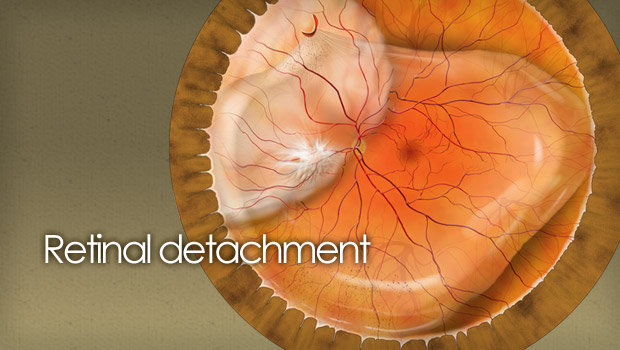
The retina is the nerve cell layer of the eye and acts much like film in a camera. When light enters the eye, it passes through the cornea and lens, which focus it onto the retina. The retina transforms the light energy into vision and sends the information back to the brain through the optic nerve. The macula is the sensitive,central part of the retina and provides for sharp, detailed vision.
In retinal detachment, the retina separates from the outer layers of the eye thus losing its function. If not treated early, retinal detachment may lead to impairment or complete loss of vision.
Most retinal detachments are preceded by one or more tears or holes in the retina.Fluid passes through these openings and separates the retina from the adjacent layers of the eye.
Near-sighted individuals are more commonly affected due to thinning of the retina. Holes or tears can then develop in the thinned retina. The vitreous (gel fluid in the eye) also plays a significant role by causing tugging on the retina especially when shrinkage occurs. Cataract surgery can also be a precipitating cause. A positive family history of retinal detachment is another risk factor.
A combination of factors is usually responsible for retinal detachment. Retinal Detachments can also be caused by other diseases in the eye such as tumors, severe inflammation, or complications of diabetes.

Middle-aged and older persons may see floating black spots called floaters and flashes of light. In most cases, these symptoms do not indicate serious problems. In some eyes, the sudden appearance of spots or flashes of light may herald the onset of retinal detachment. A thorough examination of the retina by an ophthalmologist after dilatation of the pupil is necessary to determine the cause of the symptoms.Some retinal detachments can proceed unnoticed until a large section of the retina isdetached. In these instances, patients may notice the appearance of a dark shadow in some parts of their vision. Further development of the retinal detachment willblur central vision and create significant sight loss in the affected eye.
A few detachments may occur suddenly and the patient will experience a total loss of vision in one eye. Similar rapid loss of vision may also be caused by bleeding into the vitreous which may happen when the retina is torn.
Surgery for retinal detachment is usually done under a local anaesthesia. General anaesthesia is used in children and some specific cases.
The different surgical treatments for a detached retina are explained below.
If the detachment is relatively small and uncomplicated, a procedure called pneumatic retinopexy may be used. This involves injecting a small bubble of gas into the eye, which presses the retina back into place. Laser or freezing treatment is often then used to create scar tissue that keeps the retina in the correct place. The bubble is slowly absorbed into the eye over the following weeks. After the procedure, you will be asked to keep your head in a certain position for a while, known as "posturing", so the bubble settles in the correct position.
If you have had a gas bubble put in your eye, you will not be able to travel by air for a while. Your doctor will tell you when it is safe to fly again. If you need another operation that requires general anaesthetic, you must tell your doctors about the gas bubble in your eye.

Scleral buckling involves fine bands of silicone rubber or sponge that are stitched onto the outside white of the eye (the sclera) in the area where the retina has detached. The bands act like a buckle and press the sclera in towards the middle of the eye, so the torn retina can lie against the wall of the eye.
Laser or freezing treatment is used to scar the tissue around the retina, which creates a seal between the retina and the wall of the eye and closes up the tear or hole. The bands can be left on the eye and should not be noticeable after the operation.
Vitrectomy works by removing the fluid from the inside of the eye and replacing it with either a gas or silicone bubble. This holds the retina in position from the inside. A vitrectomy may be recommended if the fluid in front of the eye is unusually thick and dense and is pulling the retina away from the underlying blood vessels.
As with a pneumatic retinopexy, posturing will be necessary to ensure the bubble is in the right place. The same restrictions on flying and precautions for further surgery that apply to pneumatic retinopexy also apply to vitrectomy.
Over 90% of all retinal detachments can be reattached by modern surgical techniques. Occasionally, more than one operation may be required. The degree of vision which finally returns about six months after successful surgery depends upon a number of factors.
Visit us at Insight Eye Clinic and experience unrivalled professional service from the moment you step in. We offer the best retinal detachment surgery in India and assure our clients the highest quality eye care.
